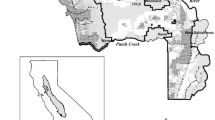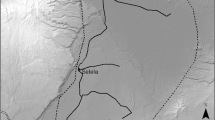Abstract
Context
Development of systematic methods for conservation planning has improved effectiveness and efficiency of implementing such plans. The lesser prairie-chicken (Tympanuchus pallidicinctus) is a grouse species of conservation concern native to the southwestern Great Plains of the United States. Recent lesser prairie-chicken conservation planning has involved identifying ecologically important areas but has not incorporated economic data into prioritization of areas to target for conservation management.
Objectives
We used the program Marxan to develop a decision-support tool for managers in Kansas to prioritize tracts for improving lesser prairie-chicken habitat quality and increasing habitat availability. We developed three different conservation scenarios and evaluated the tradeoffs among multiple planning objectives in these scenarios.
Methods
We incorporated population targets from an existing conservation plan and agricultural economic data to help select land with maximum ecological value and minimum economic productivity to prioritize for lesser prairie-chicken conservation. We compared potential conservation plans and incorporated a post hoc connectivity model to test potential for individuals to travel among habitat patches in these plans during dispersal events.
Results
We found that different conservation scenarios led to different solutions, though differences varied by ecoregion. Potential solutions for all scenarios contained habitat patches not currently included in existing conservation plans and had high connectivity potential.
Conclusions
These results provide context for spatial prioritization of lesser prairie-chicken habitat management in Kansas. Application of this approach to species of conservation interest could help managers incorporate socioeconomic factors into planning methods and identify important tracts for conservation currently overlooked by existing planning methods.






Similar content being viewed by others
References
Ardron JA, Possingham HP, Klein CJ (2010) Marxan Good practices handbook, version 2. Pacific Marine Analysis and Research Association, Victoria
Ball IR, Possingham HP, Watts M (2009) Marxan and relatives: Software for spatial conservation prioritisation. In: Moilanen A, Wilson KA, Possingham HP (eds) Spatial conservation prioritisation: quantitative methods and computational tools. Oxford University Press, Oxford, pp 185–195
Belote RT, Dietz MS, McRae BH, Theobald DM, McClure ML, Irwin GH, McKinley PS, Gage JA, Aplet GH (2016) Identifying corridors among large protected areas in the United States. PLoS ONE 11(4):e0154223
Boal CW, Grisham B, Haukos DA, Zavaleta JC, Dixon C (2014) Lesser prairie-chicken nest site selection, microclimate, and nest survival in association with vegetation response to a grassland restoration program. U.S. Geological Survey Open-File Report, Reston
Boal CW, Haukos DA (2016) The lesser prairie-chicken. In: Haukos DA, Boal CW (eds) Ecology and conservation of lesser prairie-chickens. CRC Press, Boca Roton, pp 1–11
Dahlgren DK, Rodgers RD, Elmore RD, Bain MR (2016) Grasslands of western Kansas, north of the Arkansas River. In: Haukos DA, Boal CW (eds) Ecology and conservation of lesser prairie-chickens. CRC Press, Boca Roton, pp 259–279
Earl JE, Fuhlendorf SD, Haukos D, Tanner AM, Elmore D, Carleton SA (2016) Characteristics of lesser prairie-chicken (Tympanuchus pallidicinctus) long-distance movements across their distribution. Ecosphere 7(8):e01441
Ferraro PJ (2003) Assigning priority to environmental policy interventions in a heterogeneous world. J Policy Anal Manage 22(1):27–43
Game ET, Grantham HS (2008) Marxan user manual: for Marxan version 1.8.10. University of Queensland, St. Lucia, Queensland, Australia, and Pacific Marine Analysis and Research Association, Vancouver
Garton EO (2012) An assessment of population dynamics and persistence of lesser prairie-chickens. Unpublished manuscript. Western Association of Fish and Wildlife Agencies
Hagen CA, Giesen KM (2005) Lesser prairie-chicken (Tympanuchus pallidicinctus). Cornell Lab Ornithol. https://doi.org/10.2173/bna.364
Hagen CA, Grisham BA, Boal CW, Haukos DA (2013) A meta-analysis of lesser prairie-chicken nesting and brood-rearing habitats: implications for habitat management. Wildl Soc Bull 37(4):750–758
Hagen CA, Jamison BE, Giesen KM, Riley TZ (2004) Guidelines for managing lesser prairie-chicken populations and their habitats. Wildl Soc Bull 32(1):69–82
Hagen CA, Pitman JC, Loughin TM, Sandercock BK, Robel RJ, Applegate RD (2011) Impacts of anthropogenic features on habitat use by lesser prairie-chickens. In: Sandercock BK, Martin K, Segelbacher G (eds) Ecology, conservation, and management of Grouse. Studies in Abian Biology. University of California Press, Berkeley, pp 63–76
Haukos DA, Flanders AA, Hagen CA, Pitman JC (2016) Lesser prairie-chickens of the sand sagebrush prairie. In: Haukos DA, Boal CW (eds) Ecology and conservation of lesser prairie-chickens. CRC Press, Boca Roton, pp 281–298
Haukos DA, Zavaleta JC (2016) Habitat. In: Haukos DA, Boal CW (eds) Ecology and conservation of lesser prairie-chickens. CRC Press, Boca Roton, pp 99–132
Hermoso V, Kennard MJ, Linke S (2012) Integrating multidirectional connectivity requirements in systematic conservation planning for freshwater systems. Divers Distrib 18(5):448–458
Ibendahl G, O’Brien D, Haag L, Holman J (2019) 2019 Farm management guides for irrigated crops. Kansas State University Department of Agricultural Economics. http://agmanager.info/farm-mgmt-guides/2019-farm-management-guides-irrigated-crops-0. Accessed 10 Jan 2019
Jamison BE (2000) Lesser prairie-chicken chick survival, adult survival, and habitat selection and movements of males in fragmented rangelands of southwestern Kansas. MS thesis, Kansas State University
Kansas Biological Survey (2016) Vertical structures in Kansas—FAA, March 2016. http://kars.ku.edu/geonetwork/srv/en/main.home?uuid=e256fcfd-88ac-4adb-a7af-35b8083384ad. Accessed 10 Jan 2019
Kansas Health Institute (2017) Chartbook: racial and ethnic health disparities in a changing Kansas. https://www.khi.org/policy/article/17-39. Accessed 15 Mar 2020
Kansas State University Department of Agricultural Economics (2019) About. Kansas State University. http://agmanager.info/about. Accessed 10 Jan 2019
Knight AT, Cowling RM, Difford M, Campbell BM (2010) Mapping human and social dimensions of conservation opportunity for the scheduling of conservation action on private land. Conserv Biol 24(5):1348–1358
Littlefield CE, McRae BH, Michalak JL, Lawler JJ, Carroll C (2017) Connecting today’s climates to future climate analogs to facilitate movement of species under climate change. Conserv Biol 31(6):1397–1408
Margules CR, Pressey RL (2000) Systematic conservation planning. Nature 405(6783):243
McClure ML, Dickson BG, Nicholson KL (2017) Modeling connectivity to identify current and future anthropogenic barriers to movement of large carnivores: a case study in the American southwest. Ecol Evol 7(11):3762–3772
McDonald L, Griswold J, Rintz T, Gargner G (2014) Range-wide population size of the lesser prairie-chicken: 2012 and 2013. Wildl Soc Bull 38:536–546
McRae BH, Shah VB, Mohapatra TK (2013) Circuitscape 4 User Guide. The Nature Conservancy
Naidoo R, Balmford A, Ferraro PJ, Polasky S, Ricketts TH, Rouget M (2006) Integrating economic costs into conservation planning. Trends Ecol Evol 21(12):681–687
NRCS (2016) Lesser prairie-chicken initiative: FY16-18 conservation strategy. United States Department of Agriculture
Pitman JC, Hagen CA, Robel RJ, Loughin M, Applegate RD (2005) Location and success of lesser prairie-chicken nests in relation to vegetation and human disturbance. J Wildl Manag 69:1259–1269
Plumb RT, Lautenbach JM, Robinson SG, Haukos DA, Winder VL, Hagen CA, Sullins DS, Pitman JC, Dahlgren DK (2019) Lesser prairie-chicken space use in relation to anthropogenic structures. J Wildl Manag 83(1):216–230
Polasky S, Camm JD, Garber-Yonts B (2001) Selecting biological reserves cost-effectively: an application to terrestrial vertebrate conservation in Oregon. Land Econ 77(1):68–78
Pressey RL, Bottrill MC (2009) Approaches to landscape-and seascape-scale conservation planning: convergence, contrasts and challenges. Oryx 43(4):464–475
Pressey RL, Humphries CJ, Margules CR, Vane-Wright RI, Williams PH (1993) Beyond opportunism: key principles for systematic reserve selection. Trends Ecol Evol 8:124–128
Pruett CL, Patten MA, Wolfe DH (2009) Avoidance behavior of prairie grouse: implications for wind and energy development. Conserv Biol 23:1253–1259
Reid R, Tayler M (2016) KSU-Budgeting for a Pasture Rental Rate. Kansas State University Department of Agricultural Economics, Manhattan
Reid R, Tonsor G (2017) KSU-beef farm management guide budgets. Kansas State University Department of Agricultural Economics, Manhattan
Reinhardt JR, Naugle DE, Maestas JD, Allred B, Evans J, Falkowski M (2017) Next-generation restoration for sage-grouse: a framework for visualizing local conifer cuts within a landscape context. Ecosphere 8(7):e01888
Ribeiro BR, Atadeu M (2019) Systematic conservation planning: trends and patterns among highly-cited papers. J Nat Conserv 50:125714
Rohweder MR (2015) Kansas Wildlife Action Plan. Ecological Services Section, Kansas Department of Wildlife, Parks and Tourism in cooperation with the Kansas Biological Survey, Pratt
Segan DB, Game ET, Watts ME, Stewart RR, Possingham HP (2011) An interoperable decision support tool for conservation planning. Environ Model Softw 26(12):1434–1441
Sirkiä S, Lehtomäki J, Lindén H, Tomppo E, Moilanen A (2012) Defining spatial priorities for capercaillie Tetrao urogallus lekking landscape conservation in south-central Finland. Wildl Biol 18(4):337–353
Spencer D, Haukos D, Hagen C, Daniels M, Goodin D (2017) Conservation reserve program mitigates grassland loss in the lesser prairie-chicken range of Kansas. Glob Ecol Conserv 9:21–38
Sullins DS, Haukos DA, Lautenbach JM, Lautenbach JD, Robinson SG, Rice MB, Sandercock BK, Kraft JD, Plumb RT, Reitz JH (2019) Strategic conservation for lesser prairie-chickens among landscapes of varying anthropogenic influence. Biol Conserv 238:108213
Taylor MA, Guthery FS (1980) Status, ecology, and management of the lesser prairie chicken. Rocky Mountain Forest and Range Experiment Station, Fort Collins
United States Department of Agriculture, National Agricultural Statistics Service, Research and Development Division, Geospatial Information Branch, Spatial Analysis Research Section (2018) 2017 Kansas Cropland Data Layer. USDA NASS Marketing and Information Services Office, Washington, D.C.
Van Pelt WE, Kyle S, Pitman J, Klute D, Beauprez G, Schoeling D, Janus A, Haufler J (2013) The lesser prairie-chicken range-wide conservation plan. Western Association of Fish and Wildlife Agencies, Cheyenne
Venter O, Sanderson EW, Magrach A, Allan JR, Beher J, Jones KR, Possingham HP, Laurance WF, Wood P, Fekete BM (2016a) Sixteen years of change in the global terrestrial human footprint and implications for biodiversity conservation. Nat Commun 7:12558
Venter O, Sanderson EW, Magrach A, Allan JR, Beher J, Jones KR, Possingham HP, Laurance WF, Wood P, Fekete BM (2016b) Global terrestrial human footprint maps for 1993 and 2009. Sci Data 3:160067
WAFWA GIS Services (2013) Southern Great Plains Crucial Habitat Assessment Tool. Western Association of Fish & Wildlife Agencies. https://www.sgpchat.org/. Accessed 10 Jan 2019
Wolfe DG, Larsson LC, Patten MA (2016) The lesser prairie-chicken in the mixed-grass prairie ecoregion of Oklahoma, Kansas, and Texas. In: Haukos DA, Boal CW (eds) Ecology and conservation of lesser prairie-chickens. CRC Press, Boca Roton, pp 299–314
Acknowledgements
We thank R. Baldwin for feedback on a previous version of this manuscript and suggestions on analyses. Funding for the project was provided by the USDA NRCS Lesser Prairie-Chicken Conservation Initiative (68-3A-14-120) and Pheasants Forever. Any use of trade, firm, or product names is for descriptive purposes only and does not imply endorsement by the U.S. Government.
Author information
Authors and Affiliations
Corresponding author
Additional information
Publisher's Note
Springer Nature remains neutral with regard to jurisdictional claims in published maps and institutional affiliations.
Rights and permissions
About this article
Cite this article
Schindler, A.R., Haukos, D.A., Hagen, C.A. et al. A decision-support tool to prioritize candidate landscapes for lesser prairie-chicken conservation. Landscape Ecol 35, 1417–1434 (2020). https://doi.org/10.1007/s10980-020-01024-6
Received:
Accepted:
Published:
Issue Date:
DOI: https://doi.org/10.1007/s10980-020-01024-6




